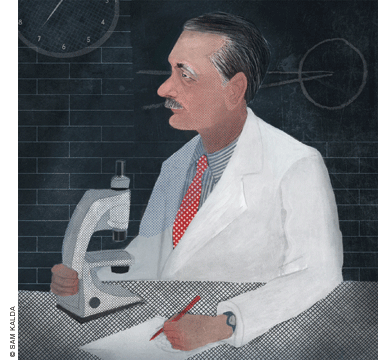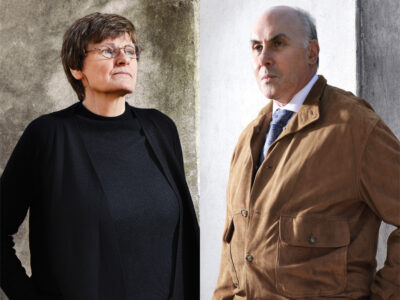
After about 20 minutes of cringing, nervous sideway glances, and uncomfortable smiles, Ralph Brinster V’60 Gr’64 decided that enough was enough. So the Penn Veterinary Medicine scientist walked to the front of the auditorium at the Vernon and Shirley Hill Pavilion, took the microphone, and told a room full of people who had gathered there to celebrate his achievements that all of the praise just heaped upon him was “a bunch of nonsense.”
Unfortunately for him, it would continue for the next two days as Brinster, the Richard King Mellon Professor of Reproductive Physiology, was honored with a symposium in late August “celebrating 50 years of scientific breakthroughs at Penn Vet.”
It was a lot to handle for a researcher who might be as famous for his humility as he is for his groundbreaking work in the fields of reproductive biology and genetics. Those who know him best say Brinster would prefer to stay underground in his white lab coat and deflect attention to his students or the University. And whenever he is recognized for his work, he usually says that he’s been lucky—a catchphrase that Joan Hendricks V’79 Gr’80, the Gilbert S. Kahn Dean of Veterinary Medicine, tries her best to ignore.
“He is very profoundly and genuinely shy,” Hendricks said. “His quality of work is towering, and it’s kind of hard to reconcile it with his humility. At first you think it’s false, but it’s not. He’s a servant to the science.”
One time last fall, however, Hendricks remembers Brinster permitting himself a brief moment of pride. He came into her office—wearing his white lab coat, of course—and told her that he had just gotten off the phone with the White House. On that call, he learned he had become the first member of the veterinary profession to be awarded the National Medal of Science, the US government’s highest honor for scientists and engineers [“Gazetteer,” Nov|Dec 2011]. Thrilled by the news, his Penn colleagues threw him a party—where, Hendricks said, “every time there was an opportunity, people jumped to their feet to applaud him.”
But some felt they needed to do more. The only problem was convincing Brinster to allow that to happen.
Two of his Penn colleagues—Narayan Avadhani, the head of the department of animal biology, and Michael Atchison, a professor of biochemistry—began to formulate plans for a symposium by creating an ambitious list of scientists they wanted to invite to Penn. They then showed the “dream list,” as Hendricks called it, to Brinster, who told them those people would never all come.
Undeterred, Avadhani and Atchison sent off invitations anyway, and “within hours—perhaps even minutes in some cases—I would get a response saying, ‘Of course I’ll be there,’” Atchison recalls.
The all-star lineup of speakers began on the first day with Brinster’s longtime collaborator Richard Palmiter, from the University of Washington, and ended with a keynote address from Nobel laureate Michael S. Brown C’62 M’66.
“I’m not sure I’ve ever seen that number of prominent people at one time at a symposium,” Brinster said later.
Brinster especially liked when they talked about their own scientific research and not about him. In other words, the opening comments were not his favorite part—even if they did please the audience to no end.
Speaking first on the podium, Steven Fluharty, senior vice provost for research at Penn, recounted stories of Brinster’s “legendary” hard work, including the time Fluharty walked into an almost entirely empty office just to pick up some papers, ran into Brinster, and then quickly scurried home. “After all,” Fluharty said, “it was Christmas Eve.”
Fluharty credited Brinster with being not just a biomedical pioneer but a “catalyst” whose research has inspired “generations of young people to go on to do great things in their own right.” That’s the sort of encomium that’s trotted out more than is merited, but in Brinster’s case it’s the truth. His development of techniques for manipulating mouse embryos is widely credited with making the mouse the primary mammalian genetic model for understanding the basis of human biology and disease. Every modern experiment involving embryonic stem cells, gene-knockout technology, cloning, and in-vitro fertilization owes a direct debt to the methods Brinster pioneered.
Speakers painted a picture of a reluctant leader. Hendricks said she first met Brinster when he was on the committee to decide whether or not she’d be accepted as a student into the veterinary school, and remembers feeling awestruck. For the next 38 years, that feeling never changed. “I will say that he dislikes being a leader, but he is,” Hendricks said. “He can’t avoid it.”
By the time it was Brinster’s turn to speak at the end of the second day, he managed not to “lower his head as if he’s being beaten,” which is the way Hendricks describes his reaction to praise.
“This is probably one of the few times I’m happy to talk,” Brinster opened, “because I can end these inflated accolades.”
He then went on to humbly recap his five-plus decades of work, from early experiments on mouse eggs and embryos in the 1960s to his transformative discoveries in the field of mammalian transgenesis—the process of introducing outside genes into the germline of a developing organism so that it will exhibit a new characteristic, and transmit that characteristic to its offspring.
Unsurprisingly for a man who is uncomfortable receiving laurels, Brinster gave no impression that he was ready to rest on his. In the middle of his presentation, he mentioned just having secured a new grant. “So I’ll be around for a while,” he said.
Or indefinitely, if he has his way. “I enjoy the work,” he said later. “I enjoy the research. I enjoy finding new things. So I don’t really see a reason to retire.”
That, of course, cheered the audience, who responded by giving the man of the hour a standing ovation. Brinster looked out at them, smiling, humbled, and probably still a little embarrassed.
“Enough,” he said, urging them to sit back down. And then he made sure to throw in his famous line, misleading though it may be: “I’ve just been lucky.”
—Dave Zeitlin C’03




